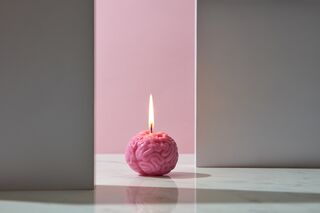OCD
When OCD Is Invisible
Just because you can't see compulsions doesn't mean they're not a problem.
Posted August 2, 2022 Reviewed by Tyler Woods
Key points
- Pure-O, or Pure Obsessional OCD, contain compulsions, and "mental actions" are no different from the "physical actions" of the OCD cycle.
- Mental compulsions can be minimized through mindful awareness, attention training, and exposure therapy.
- While you do not have control over intrusive thoughts, you have control over where you intentionally place your thoughts and energy.
What is Pure-O?
Pure Obsession, or Pure OCD, is a term used to describe an Obsessive-Compulsive Disorder manifestation where the obsessions take place covertly inside your mind or body. The term originally was used to describe someone who seemingly does not have any compulsions. Instead, they reported only excessive or continuous rumination or only “obsessions.”
Purely Obsessional OCD (Pure-O) is not a diagnosis unto itself. It is simply one way OCD manifests itself and generally outlines the ways in which the individual will exhibit symptoms or interact with their feared stories (i.e., obsessions). Any broader subtype of OCD can either include Pure-O traits. These can include SO-OCD with mental or emotional checking, Religious Scrupulosity with compulsive prayer, and contamination obsessions with mental checking or neutralization, just to name a few.
The Diagnostic and Statistical Manual, 5th edition, describes compulsions as “Repetitive behaviors (e.g., hand washing, ordering checking) or mental acts (e.g., praying, counting, repeating words silently) that the person feels driven to perform in response to an obsession, or according to the rules that must be applied rigidly.”

“Pure-O” is, therefore, a misnomer. While the person with Pure-O does not have external or overt compulsions, they are still engaging in internal compulsions, actions, efforts, or processes to neutralize, negate, undermine, or eliminate the uncertainty, doubt, and unwanted feelings. In other words—compulsions.
Why Mental Compulsions Are A Problem
As people who are faced with decisions and the complexities of life, we should think, weigh the options, and consider the pros and cons when making decisions for the future or evaluating how to improve. But OCD hijacks this process creating an endless, self-reinforcing, feedback loop. People engaging in mental compulsions often feel like they are doing the right thing by reviewing or planning ahead. They feel like they will discover a mistake so they can atone for mistakes or mend a relationship. Or, at the very least, it makes them feel better temporarily.
But, it is all just another compulsive trap. It may not be washing your hands, or putting things in alphabetical order, but it is still an intentional, effortful action to eliminate anxiety, exorcise uncertainty, and restore a sense of safety.
Know Thyself
In order to stop mental compulsions, you have to be aware that you are doing them. Reviewing the list above should be a good primer for recognizing types of compulsive thought patterns. Go back and review the list and make a note of which one(s) you do. For bonus points, write down how that specific mental compulsion shows up in your life, when it’s most likely to show up, and what you are hoping to accomplish by doing them. Most importantly in this exercise, be honest with yourself.
How Can I Stop Mental Compulsions?
Stopping mental compulsions can be a tricky business, especially since these mental behaviors mask themselves as the typical thought process. To that end, If we are being honest, it is a typical thought process inasmuch as a hammer is good for a nail: a few whacks and you’re typically good to go, but when a few whacks lead to more whacks, followed by a lot more whacks, you are left exhausted and with nothing to show for it.
However, we always have a choice with where and how much we invest our mental energy. Granted, sometimes the choice is hard to recognize, especially when OCD’s voice is loud. However, you have control over whether you orient your thoughts toward meaningful activity, or whether you intentionally engage in compulsive thought processes that feed the OCD monster.
Attention Training Is Not Thought Suppression
Attention training is a great way to build the “focus-shifting muscle.” Some confuse this with thought suppression or mental avoidance, however, there are key differences. Attention shifting is about gently turning your attention toward a more preferred topic, thought, or activity, whereas thought suppression aims to eliminate the non-preferred thought. In dealing with mental compulsions, once you become aware that you are engaging in mental compulsions, acknowledge the thought (for example, by saying, “Oh, I’m doing that thing again”) and gently redirect your focus elsewhere (i.e., back to your conversation, the actions involved in washing your dog, or your psych 101 lecture).
Attention Training
Here is a simple way to practice this. Put on a set of headphones and play Bohemian Rhapsody by Queen. As you’re listening, focus on Freddy’s singing. Just his singing. Notice the rasp, the punch, the gentle glissando fall at the end of his phrases. Now, shift and listen to the guitar. Only the guitar. The note’s crisp attack, how notes are played after or before the beat for emphasis, the smooth vibrato. If you did this and got distracted by listening to the bass for a moment, don’t get upset. Sure, John Deacon’s playing is immaculate, but not the focus of the exercise. For now, ignore his playing, like most people usually do, and gently bring your focus back to the guitar.

Did you notice how you were able to selectively refocus your attention? Did you also notice that sometimes, despite your best efforts, you got distracted? That’s expected, normal, and human. Did you also notice that when you focused on the guitar, you still heard the other instruments and the singer? You weren’t trying to pretend as if the other sounds weren’t there because they were there. Same with the thoughts. Your goal with this exercise was to build your skill, confidence, and self-compassion in willfully and nonjudgmentally focusing on a thought or stimulus of your choice and gently shift back to it when you were distracted.
Acceptance and Exposure and Response Prevention
If you are tired of repetitive mental compulsions and are ready to take the risk to cut them out, you are effectively doing your own Exposure and Response Prevention (ERP). ERP is the primary therapeutic focus for all types of OCD and is most commonly used to break the obsessive-compulsive cycle. When you recognize you have fallen back into a mental compulsion, that’s ok. Compassionately acknowledge that you did it, recognize you were aware of it, and redirect your attention and mental energy elsewhere.
When you do disrupt the mental compulsion and resist giving in to the obsessive doubt, you leave the obsession unanswered and allow the uncertainty/ anxiety to linger. You accept a temporary discomfort. But, it will go away. It always does and always will...eventually. When you commit to interrupting your compulsive thoughts and behaviors, you build confidence that the anxiety goes away, all on its own, without compulsions.
If you are ready to take this leap, there are a ton of resources out there that discuss ERP and acceptance in greater detail. Better yet, you can reach out to a therapist and begin working with them to directly face your feared thoughts and feelings through structured ERP, and with the tools that you’ve learned in this article, you will be prepared to disengage with mental compulsions, redirect your focus back on your life, and take control over your relationship with OCD ridden thoughts and feelings.
This article is part II of a two-part series on mental compulsions. Part I provides an overview of the OCD cycle, a brief description of thirteen different mental compulsions, and examples of how mental compulsions work within the OCD cycle.
To find a therapist near you, visit the Psychology Today Therapy Directory.
References
American Psychiatric Association. (2013). Diagnostic and statistical manual of mental disorders (5th ed.). https://doi.org/10.1176/appi.books.9780890425596.




